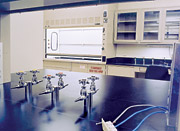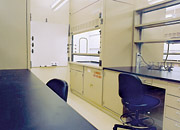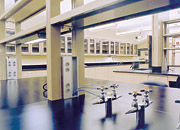
But basement-level shell space at the Harry S. Truman Memorial Veterans Hospital in Columbia, MO, was available, and it became one of three options investigated for the hospital's new research laboratories.
Compared to other alternatives, which included renovating existing occupied spaces and constructing a new building, the unfinished shell space didn't look half bad. It was centrally located near the researchers' existing labs. An underground tunnel connected the space to the University of Missouri across the street. (Research performed in the space was to be a collaboration of the Veterans Administration and the university.) Perhaps most notably, it had sewer lines, water mains, and other central utilities already in place, promising significant cost savings.
The basement location also created some design challenges - not the least of which was transforming a space with no windows and low ceilings into an environment that researchers would actually want to work in.
Those aesthetic challenges, however, paled in comparison to the widely varying technical requirements of the spaces contained in the labs. The engineers' success in overcoming these challenges and transforming the shell into a model environment for radiopharmaceutical and immunology research earned the project the Honor Award from the American Council of Engineering Companies of Missouri - and increased the hospital's research capacity by 30%.
Today, eight principal investigators and more than two dozen technicians make their professional homes in the 13,200-sq-ft basement space. This is the story of what it took to get them there.
Diverse Research Requirements
Back in the late 1990s, two different VA research groups were in need of additional lab space. One group biomedically designs radioactive drugs that target cancer cells in the body. Theirs is a multifaceted program, with research focused on coupling radioactive molecules with biological molecules to carry radioactive isotopes directly to cancer cells.A second group operates an immunology research lab that focuses on developing better ways to treat the immune system and arthritis. Core activities include tissue culture and molecular biology.
Burns & McDonnell designers had their basic needs in mind when they recommended the basement shell for their laboratories. To further define the space requirements for the two diverse groups, they turned to Health Education and Research Associates (HERA) (St. Louis), to provide laboratory programming support and early design planning.
HERA began by asking prospective laboratory occupants to complete detailed questionnaires to determine individual needs, requirements, and preferences. This information helped designers group scientific and administrative functions together to achieve synergies between different groups. It also gave the occupants an opportunity to participate in the planning and design of their new space.
From Concept To Clinical Trial
What resulted - and what is perhaps most significant about the research facilities - is their sheer scope. The expansion gives researchers everything they need to take a drug from concept through clinical trial in one place. "Ordinarily, one lab might be responsible for developing a concept, but then the research would have to move through one or two more labs before it reached clinical trial stage," said Gary Langley, the hospital's director of facilities management. "In our case, anything needed for the research is all right here."The facility includes everything from "hot cell labs" - glass-encased Class 100 cleanrooms where researchers work with high-level radioactive materials - built within feet of other, nonradioactive labs.
Also included is a nuclear magnetic resonance lab, an MRI, live-animal and biolabs, high- and low-level radioactive labs, discovery labs, and pharmaceutical manufacturing laboratories. The space also contains refrigerator and freezer rooms, a deionized water generator, a glass wash area, autoclaves, as well as offices, computer rooms, and conference rooms.
The complex mix of lab requirements, coupled with the overall need for flexibility made the design challenging on many levels.

Building Codes Conflict
Due to the diverse nature of the work being done in the radiopharmaceutical research labs, for example, designers often found themselves working with conflicting building codes."When performing pharmaceutical work, the goal is to protect the end-product from the environment so it does not become contaminated," said Ken Francis, director of laboratory design for Burns & McDonnell. "But when you're working with radioactive materials, the goal is to protect the environment from the product so radioactive particles are prevented from spreading."
In this case, the end product was both a pharmaceutical drug and a radioactive material. Steps had to be taken, therefore, to protect both the product from the environment and the environment from the product.
The solution was highly pressurized cleanrooms with cascading air pressures in adjoining spaces to keep contaminants out of the product. Radioactive products were contained inside heavily lead-lined enclosures kept at a very negative air pressure.
Creating cleanrooms in a limited space environment
IAQ played a major role in the design process, not just to ensure the health and comfort of the lab personnel, but also to ensure the success of the testing and experiments occurring inside the laboratories. A single lapse in laboratory air quality could invalidate experiments and ruin months of research and work. Workers also needed to be protected from the potentially toxic, noxious, or hazardous fumes generated during some experiments.Given the critical nature of the research and the need to manufacture pharmaceutical products, several critically clean environments (cleanrooms) were needed to purify the air.
Cleanrooms are classified by the number of particles of 0.3 microns in size (or larger) per cubic foot. The cleanrooms on this project ranged from Class 100,000, or fewer than 100,000 particles per cubic foot, down to a Class 1,000.
To achieve this air quality, engineers traditionally depend on large AHUs with HEPA filters and a raised, perforated floor. The low ceiling and other space limitations at the project site could not accommodate either one. Instead, engineers integrated the HVAC components with the building's structural elements, achieving Class 1,000 cleanroom environments without the need for a raised floor or dedicated air-handling system.
In the Class 1,000 cleanroom - where the air can be completely changed and filtered 150 to 250 times an hour - a supply air plenum was constructed above the room using sterile cleanroom ceiling grid tiles. Fresh air from the outside was designed to be prefiltered, heated, or cooled to satisfy room conditions, and then delivered to this supply-air plenum.
Specially constructed fan-powered HEPA filters mounted in the cleanroom's ceiling then provide final purification of the air. This pure air is then slowly supplied to the space at velocities of 100 fpm or less to create a laminar flow pattern. As the pure air washes over the people and equipment in the space, it picks up any contaminants created. The now "dirty" air is picked up at floor level and returned to the fan-powered HEPA filters to be cleaned and returned to the space. The space is pressurized to prevent contaminants from adjoining spaces from entering the cleanroom.
Current good manufacturing practices (cGMP) say facilities like these must be completely cleanable. Given the low ceiling height, however, a raised floor for picking up return air was not possible. So engineers and architects worked together to create a wall system that functioned as both a structural wall and a return air plenum. Studs were redesigned to be spaced wider and deeper to accommodate the return air system. Low side wall return filter grilles collect the "dirty" air at floor level and return it to the supply air plenum and fan-powered HEPA filters. This created a semi-laminar airflow pattern over critical work spaces.
Isolating the Labs from 'Wind Tunnel' Conditions
Designers were also challenged with isolating the air in the laboratories from an adjacent hallway."The hallway between the laboratories connects to a tunnel between the university facilities across the street and the VA hospital above," said Francis. "The two facilities operate independently of each other and the air pressures vary widely." As a result, the underground tunnel often becomes a "wind tunnel" as air transfers from one building to the other, resulting in widely varying air pressures just outside the laboratories.
To isolate the laboratories from these conditions, engineers designed a set of pressurized air locks at the entries to the laboratories. Small entry rooms have electronically interlocked doors; one door must be completely closed before the other door can open. Emergency overrides installed on the wall allow for egress in an emergency or for maneuvering large equipment into the labs. The air locks have vision panels that can be monitored by lab personnel for an added degree of physical security.
Radioactive laboratory work is typically performed in heavy, lead-lined rooms to contain the radiation within the room. Supporting the weight of heavy lead-shielded walls, however, can create structural problems and add substantially to a project's cost.
To minimize this problem, engineers used a small lead-lined chamber, called a hot cell, for performing all highly radioactive work. This chamber includes layers of lead brick shielding and a special foundation designed to support the more than 30,000-lb weight of the hot cell. A dedicated exhaust system ensures the enclosure is kept at a negative pressure, even when the chamber door is open.
Air from the chamber is exhausted through specially welded, seamed ductwork to an exhaust fan on the roof. Another exhaust fan is installed to provide 100% backup exhaust to engage instantly if the primary exhaust fan should fail, ensuring constant protection in the laboratory.
Lead shielding creates structural challenges
Radioactive laboratory work is typically performed in heavy, lead-lined rooms to contain the radiation within the room. Supporting the weight of heavy lead-shielded walls, however, can create structural problems and add substantially to a project's cost. To minimize this problem, engineers used a small lead-lined chamber, called a hot cell, for performing all highly radioactive work. This chamber includes layers of lead brick shielding and a special foundation designed to support the more than 30,000-lb weight of the hot cell. A dedicated exhaust system ensures the enclosure is kept at a negative pressure, even when the chamber door is open. Air from the chamber is exhausted through specially welded, seamed ductwork to an exhaust fan on the roof. Another exhaust fan is installed to provide 100% backup exhaust to engage instantly if the primary exhaust fan should fail, ensuring constant protection in the laboratory.
Operation and Maintenance Issues
Creating these specialized indoor environments is a challenge. Perhaps an even greater challenge, however, is maintaining these environments throughout the laboratories' life.That's why systems throughout the facility were designed to be as dependable, simple, and low maintenance as possible, while still accomplishing research personnel requirements and meeting the hospital's "one step beyond" attitude on quality and safety. It's also why design engineers involved both the endusers and the maintenance personnel in ongoing consultations and reviews throughout design.
Their involvement translated into multiple added design elements that helped ensure the design both met their research needs and was easy to operate and maintain.
For example, equipment was located in corridors and chases, where possible, so that researchers would not be disturbed during maintenance procedures. Similarly, supply air terminals for the laboratories and cleanrooms were located in the hallway plenum space so that maintenance personnel would not have to enter the cleanrooms or laboratory environments to service the equipment.
System controls were also given detailed consideration during design. The laboratories' controls system was designed as standalone system that could be easily validated for Federal Drug Administration approval. It was configured so that it could also be interconnected with the existing building's emergency management system for monitoring from the building's central EMS control stations.
Based on enduser recommendations, static pressure monitors were installed at eye-level on the walls of laboratory entries and cleanrooms so that research personnel can field-verify room pressurization levels. Room pressurization levels are maintained through the use interlocked electronic air valves that require almost no maintenance once their design cfm has been set.
Back to the Basement
Smart engineering and technical innovation could provide the bells, whistles, and functionality to please the most demanding researcher, but it couldn't erase the fact that researchers would be working in a basement with no windows and low ceilings.To help quell negative perceptions about the lack of natural lighting, designers needed to work doubly hard to create a bright and open feeling within the space. Designers addressed this issue through an innovative approach to lighting and the use of glass windows between offices and labs. Pendant-mounted lights were hung from the space's 9-ft ceilings. These lights direct their beams upward to the ceiling, which then diffuses and distributes light evenly throughout the lab using indirect lighting. Light levels in the labs were increased to over 100 foot-candles/sq ft to give researchers good contrast for critical task work while use of indirect overhead lighting fixtures reduce computer screen glare.
Even with the technical advances the engineers and architects designed, the project design still was achieved on schedule and under budget. Senator Christopher "Kit" Bond (MO), who had helped secure $3.9 million in federal funds for the project, presided over the dedication last year. "State of the art research demands state of the art research facilities," he said at the time. Even when you're working in the basement. ES
Founded in 1898, Burns & McDonnell is an international engineering, architecture, construction and environmental services firm with more than 1,700 employees and 19 offices worldwide. More information on the company is available at www.burnsmcd.com
